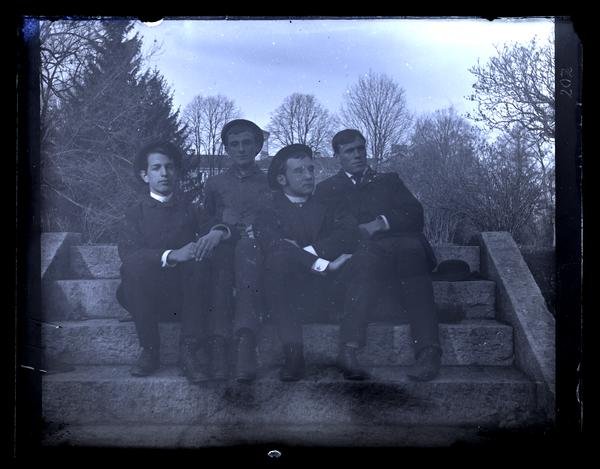TW Richards just north of the Beach House Hotel in 1886 - Marriott C. Morris Collection Library Company of Philadelphia
The man sitting intently looking into Sea Girt’s foamy sea in 1886 was the 18-year-old son of a famous artist. Theodore W. Richards was a Haverford classmate of Marriott Canby Morris and he spent three weeks at Sea Girt that summer.
Teddy Richard’s father was William Trost Richards a renowned landscape/seascape painter from Germantown Pa. William produced near-photorealistic renderings. His watercolors of the White Mountains and the East Coast are still celebrated for their accurate attention to detail.
Teddy described his father’s concentration, which may explain his own reflection, staring at the sea, “He stood for hours in the early days of Atlantic City or Cape May, with folded arms, studying the motion of the sea,—until people thought him insane. After days of gazing he made pencil notes of the action of the water. He even stood for hours in a bathing suit among the waves, trying to analyze the motion.”
Teddy was homeschooled by his mother, Anna (Matlack) Richards, a poet from a prominent Quaker family. Anna was disowned and ‘written out of meeting’ when her husband quit his mechanic’s job and took up artistic painting. She dove into educating her young children. Teddy excelled, entering college at 14.
He credited his Mom for her dedication, “Drawing and music were included in this home curriculum and so, of course, were reading, writing, arithmetic and geography as well as much more history than is usually taught to young children. . . . My mother's devotion was tireless and beyond praise. My debt to her (as well as to my father) is inestimable."
At the time of the photo, Teddy had just finished a second Bachelor of Science degree at Harvard. His mother had learned Greek to teach it to Teddy, so he could test into the senior class at Harvard.
One could imagine that during his three weeks at Sea Girt, Teddy was thinking about the direction of his life.
"Although my parents had no experience with scientific investigation, their tastes and education having been of a very different kind, nevertheless they entered fully into the spirit of my desire to undertake it and were wise enough to see that a possible future lay ahead for me in the path which so profoundly interested me. From that time my father always advised me to devote myself as much as possible to research. Moreover, he supported this advice in a very practical way (realizing that research in pure science is not a money-getting employment) and offered always to help me.”
Right around this time, Teddy decided to dive deeply into atomic chemistry, earning his Harvard Ph.D. by 1888.
Richards was the first to show that an element could have different atomic weights through the discovery of isotopes, and he and his students accurately established atomic weights for 35 different elements. For his work in this area, he was the first American to be awarded a Nobel Prize in Chemistry in 1915. Williams died in 1928 in Cambridge Mass.
In a Biographical memoir of Teddy written by James Bryant Conant and commissioned by the National Academy of Sciences in 1974, Conant notes that when Teddy left his family home to go to school, he carried with him two sonnets written by his mother, “a remarkable and brilliant woman.”
Fear not to go where fearless Science leads,
Who holds the keys of God. What reigning light
Thine eyes discern in that surrounding night
Whence we have come, what law that supersedes
The fiat of all oracles and creeds,
Thy soul will never find that Wrong is Right.
Morris photographed members of his German class at Haverford in 1883. 14 year-old Teddy W, Williams is on the left Marriott C. Morris Collection Library Company of Philadelphia
Seascape with distant lighthouse, Atlantic City 1873, by William Trost Richards Tyhssen Borenmisza Museum



